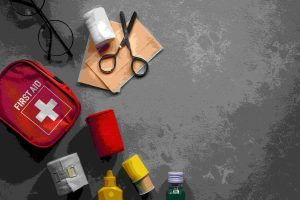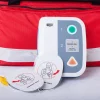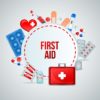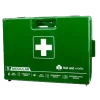
Recent Post
 Could You Recognise the Signs That Someone Needs a Defibrillator?
Could You Recognise the Signs That Someone Needs a Defibrillator?
September 12, 2023
Introduction
Whether you’re a doting parent, a sports enthusiast, or an adventurous spirit, understanding the common injuries that occur in Australia and how to respond to them can be incredibly valuable. Accidents happen, and knowing first aid can mean the difference between a minor inconvenience and a major tragedy. In this article, we delve into Australia’s most common injuries, basic first aid principles, and how these skills can help. Grab a cuppa, and let’s dive in!
Understanding Common Injuries in Australia
Overview of Common Injuries
In the land Down Under, injuries can occur anywhere – on the footy pitch, at the workplace, at home, or on the open road. According to Safe Work Australia, in 2021, there were over 100,000 serious workplace injuries alone. Meanwhile, the Australian Institute of Health and Welfare found that around 60,000 Aussies end up in hospital each year due to sports-related injuries.
Detailed Exploration of Specific Common Injuries
Let’s take a closer look at the most common types of injuries in our wide brown land:
- Sports injuries: From footy to netball, sports are an integral part of Aussie culture. Unfortunately, they can result in sprains, strains, fractures, and head injuries. It’s important to remember that accidents can happen to anyone, whether they’re a weekend warrior or an elite athlete.
- Workplace injuries: Workplaces, especially those involved in manual labour like construction and agriculture, often see injuries such as cuts, burns, and even electrocutions.
- Home & recreational injuries: These can range from falls and burns to poisonings and choking, especially among kiddies.
- Motor vehicle accident injuries: Despite extensive road safety campaigns, accidents do happen and can lead to serious injuries or even fatalities.
The Basics of First Aid
Introduction to First Aid
So, what exactly is first aid? It’s immediate care provided to someone who’s been injured or fallen ill. The aim is to preserve life, prevent the condition from worsening, and promote recovery. It can be as simple as sticking a plaster on a small cut or as complex as performing CPR (Cardiopulmonary Resuscitation) on someone who’s stopped breathing.
Basic First Aid Procedures Everyone Should Know
Let’s get into the nitty-gritty of basic first aid:
- CPR: This life-saving procedure helps maintain blood flow to the brain and heart in emergency situations.
- Handling fractures and sprains: It’s important to immobilise the injury and apply ice to reduce swelling.
- Burns and scalds: Immediate cool running water is the first response to a burn.
- Treating wounds and bleeding: Applying pressure with a clean cloth and raising the wound can help stop bleeding.
First Aid for Australia’s Most Common Injuries
Now, let’s apply what we’ve learned to some of Australia’s most common injuries:
Sports Injuries
For sprains and strains, remember the RICE method – Rest, Ice, Compression, Elevation. Concussions, however, are a different kettle of fish. Any loss of consciousness, confusion, or severe headache after a knock to the head should be taken seriously.
Workplace Injuries
Cuts and burns can usually be managed with basic first aid – cleaning the wound, applying a bandage, or using cool water for burns. For more serious cases, like chemical spills or electrical injuries, it’s crucial to ensure the area is safe before providing first aid and then seek professional medical help.
Home & Recreational Injuries
At home, keeping calm is key. For falls, assess the person for any injuries. For burns, run them under cool water. If someone’s been poisoned, try to find out what they’ve ingested and call the Poison Information Centre or seek medical help.
Motor Vehicle Accident Injuries
After a car accident, the main aim is to ensure safety and call for professional help. If it’s safe to do so, providing basic first aid can be beneficial.
Importance and Benefits of First Aid Training
First aid training isn’t just for healthcare professionals; it’s valuable for anyone and everyone. It empowers you to act swiftly and confidently during emergencies, potentially saving lives. Plus, it can enhance your skills as a parent, a colleague, and a community member.
How Priority First Aid Can Empower You to Take Charge in Emergencies
Comprehensive First Aid Training
Priority First Aid provides in-depth first-aid training for both individuals and businesses. By empowering you with life-saving knowledge and practical skills, they equip you to handle emergencies with confidence and calm.
High-Quality First Aid Supplies
From basic first aid kits to advanced medical equipment, Priority First Aid offers a wide range of quality products. Their supplies ensure that you’re well-prepared to respond to various health emergencies, be it at home, at work, or out in the great outdoors.
Tailored Solutions for Businesses
Priority First Aid understands that every business has unique needs. Therefore, they offer tailored solutions to ensure your workplace is a safer environment. They assist in developing effective first-aid response strategies, reducing the potential impact of injuries and illnesses at work.
Conclusion
In the end, the importance of understanding Australia’s common injuries and knowing basic first aid can’t be overstated. Not only could it save a life, but it could also prevent a minor injury from becoming a major one. As the old saying goes, “It’s better to know it and not need it than to need it and not know it.”
1. Q: What kind of first aid training does Priority First Aid offer?
A: Priority First Aid offers a variety of first aid training courses catering to different levels of knowledge and specific needs. These range from basic first aid courses to advanced resuscitation training. They also provide specialised courses for workplaces, sports environments, and childcare settings.
2. Q: Are Priority First Aid courses accredited?
A: Yes, all first aid courses offered by Priority First Aid are nationally recognised and meet the Australian Resuscitation Council guidelines.
3. Q: What kind of first aid supplies does Priority First Aid provide?
A: Priority First Aid offers a comprehensive range of first aid supplies. This includes basic first aid kits suitable for home or small business use, more advanced kits for specific workplaces, as well as Automated External Defibrillators (AEDs), dressings, and other medical supplies.
4. Q: How can Priority First Aid’s tailored solutions benefit my business?
A: Priority First Aid can assess your business’s specific needs and risks to offer a customised first aid solution. This not only ensures your business complies with Australian Health and Safety regulations, but it also maximises the safety of your workplace for employees and customers alike.
5. Q: How can I enrol in a first aid course with Priority First Aid?
A: You can enrol in a course directly through the Priority First Aid website. If you need help choosing the right course for you or your business, their customer service team would be more than happy to assist.






